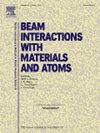Mössbuaer谱中共振线宽度不同是多维高斯分布的结果
IF 1.4
3区 物理与天体物理
Q3 INSTRUMENTS & INSTRUMENTATION
Nuclear Instruments & Methods in Physics Research Section B-beam Interactions With Materials and Atoms
Pub Date : 2025-03-07
DOI:10.1016/j.nimb.2025.165669
引用次数: 0
摘要
在对复杂材料应用莫斯鲍尔光谱学时,超频参数分布经常被用于数据处理。之所以需要分布,是因为存在大量不同的铁离子局部位置,其最近的环境也各不相同。因此,莫斯鲍尔光谱应包含大量不同的相应子谱。这通常会导致难以独立确定各个位置。最简单的情况是,由于超频参数的正态分布,共振线的宽度会增加。然而,它们可能看起来是相关的。在这种情况下,光谱的形状会发生变化,需要更复杂的模型来描述。在这项工作中,我们建立了这样一个模型,并与已有的方法进行了比较。本文章由计算机程序翻译,如有差异,请以英文原文为准。
Different widths of resonant lines in the Mössbuaer spectrum as the result of multidimensional Gaussian distribution
In the application of Mössbauer spectroscopy to complex materials distributions of hyperfine parameters are regularly utilized in data processing. Distributions are required due to existence of a huge number of different local positions of Fe ions with varying nearest environment. Thus, the Mössbauer spectrum should contain a lot of different corresponding subspectra. It often leads to a problematic independent determination of individual sites. In simplest case it could lead just to an increase of the width of resonant lines due to normal distribution of hyperfine parameters. However, they could appear to be correlated. In such case the shape of the spectrum will change, requiring more complex model to describe it. In this work such a model was developed and compared to already existed approaches.
求助全文
通过发布文献求助,成功后即可免费获取论文全文。
去求助
来源期刊
CiteScore
2.80
自引率
7.70%
发文量
231
审稿时长
1.9 months
期刊介绍:
Section B of Nuclear Instruments and Methods in Physics Research covers all aspects of the interaction of energetic beams with atoms, molecules and aggregate forms of matter. This includes ion beam analysis and ion beam modification of materials as well as basic data of importance for these studies. Topics of general interest include: atomic collisions in solids, particle channelling, all aspects of collision cascades, the modification of materials by energetic beams, ion implantation, irradiation - induced changes in materials, the physics and chemistry of beam interactions and the analysis of materials by all forms of energetic radiation. Modification by ion, laser and electron beams for the study of electronic materials, metals, ceramics, insulators, polymers and other important and new materials systems are included. Related studies, such as the application of ion beam analysis to biological, archaeological and geological samples as well as applications to solve problems in planetary science are also welcome. Energetic beams of interest include atomic and molecular ions, neutrons, positrons and muons, plasmas directed at surfaces, electron and photon beams, including laser treated surfaces and studies of solids by photon radiation from rotating anodes, synchrotrons, etc. In addition, the interaction between various forms of radiation and radiation-induced deposition processes are relevant.

 求助内容:
求助内容: 应助结果提醒方式:
应助结果提醒方式:


